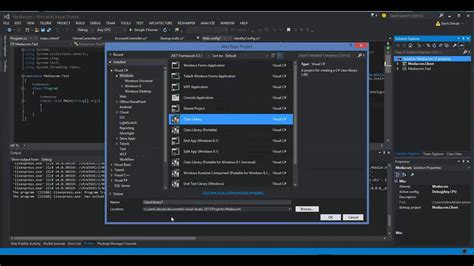How to Use SignalR in ASP.NET Web API C#
This comprehensive guide will walk you through integrating SignalR into your ASP.NET Web API C# application. SignalR allows you to build real-time, bidirectional communication between your server and clients, enhancing the user experience with features like live updates and instant messaging. We'll cover setting up the project, configuring SignalR, and handling client-server communication.
Setting Up Your Project
Before diving into SignalR integration, ensure you have the necessary prerequisites:
- Visual Studio: A recent version of Visual Studio with ASP.NET and Web API development tools installed.
- .NET SDK: The appropriate .NET SDK for your project.
Create a new ASP.NET Web API project in Visual Studio. You can choose the template that best suits your needs. For this example, we'll assume you've created a basic Web API project.
Installing the SignalR NuGet Package
The next crucial step is installing the SignalR package. Open the NuGet Package Manager Console in Visual Studio and run the following command:
Install-Package Microsoft.AspNetCore.SignalR
This command adds the necessary SignalR libraries to your project.
Creating a SignalR Hub
A SignalR Hub acts as the central communication point between your server and clients. Let's create a simple hub:
using Microsoft.AspNetCore.SignalR;
namespace YourWebApiProject.Hubs
{
public class ChatHub : Hub
{
public async Task SendMessage(string user, string message)
{
await Clients.All.SendAsync("ReceiveMessage", user, message);
}
}
}
This ChatHub allows clients to send messages, which are then broadcast to all connected clients. SendAsync is crucial for asynchronous operations, vital for maintaining responsiveness. The Clients.All property targets all connected clients. You can also use Clients.User() for specific users or Clients.Others() to exclude the sender.
Configuring SignalR in Startup.cs
Navigate to your Startup.cs file (or Program.cs in .NET 6 and later) and configure SignalR within the ConfigureServices method:
// In Program.cs (.NET 6 and later)
builder.Services.AddSignalR();
// In Startup.cs (.NET Core 3.1 and earlier)
services.AddSignalR();
Then, within the Configure method, map the SignalR hub to a URL path:
// In Program.cs (.NET 6 and later)
app.MapHub("/chatHub");
// In Startup.cs (.NET Core 3.1 and earlier)
app.UseEndpoints(endpoints =>
{
endpoints.MapHub("/chatHub");
});
This maps the ChatHub to the /chatHub URL. Clients will connect to this endpoint.
Client-Side Implementation (JavaScript)
You'll need JavaScript code on your client-side (typically within a web page) to connect to the SignalR hub and handle communication. Here’s a basic example using the SignalR JavaScript client library:
const connection = new signalR.HubConnectionBuilder()
.withUrl("/chatHub")
.build();
connection.on("ReceiveMessage", (user, message) => {
// Display the received message
const msg = `${user}: ${message}`;
console.log(msg);
// Add message to your UI
});
connection.start().catch(err => console.error(err));
document.getElementById("sendMessageButton").addEventListener("click", () => {
const user = document.getElementById("userName").value;
const message = document.getElementById("userMessage").value;
connection.invoke("SendMessage", user, message).catch(err => console.error(err));
});
Remember to include the SignalR JavaScript client library in your HTML. You can include it via a CDN or install it using a package manager like npm or yarn.
Handling Errors and Disconnections
Robust error handling is vital. Implement try...catch blocks in both your server-side and client-side code to gracefully handle exceptions and disconnections. SignalR provides events like onclose and onreconnecting that can help manage these situations.
Advanced SignalR Features
SignalR offers many advanced features:
- Groups: Organize clients into groups for targeted messaging.
- Streaming: Send data continuously to clients.
- Authentication: Securely identify and authorize clients.
This guide provides a foundation for using SignalR in your ASP.NET Web API C# applications. By mastering these concepts, you can significantly enhance your applications with real-time capabilities. Remember to consult the official SignalR documentation for further details and advanced features.
